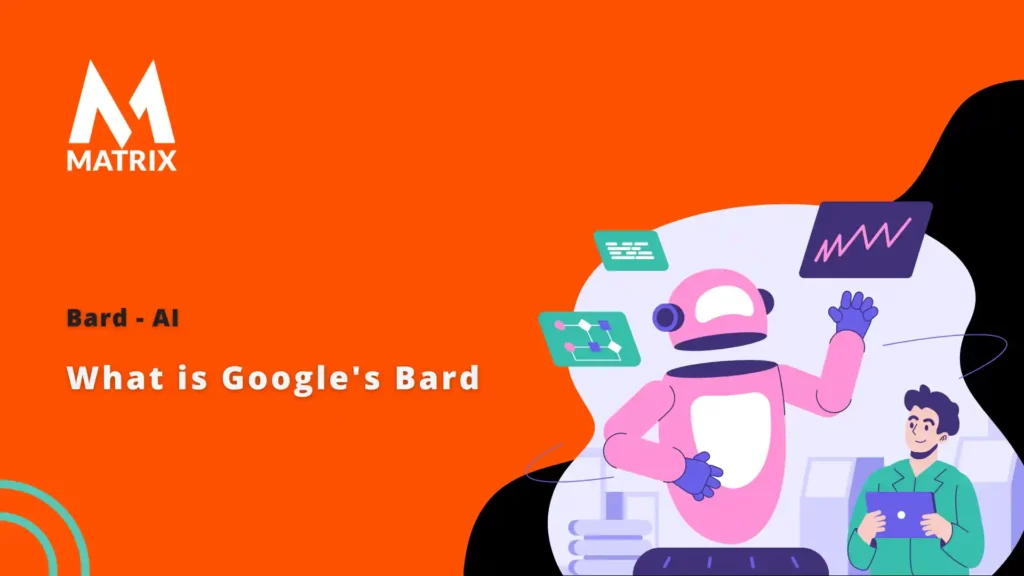What is Google’s Bard
What is Google’s Bard
Google’s Bard is a revolutionary new artificial intelligence system that promises to revolutionize how people search and interact with information. Powered by natural language processing, this advanced technology has the potential to transform how we access data and make it easier for us to find the answers we need.
In this blog post, we’ll explore what exactly Google’s Bard is, how it works, why you should not fire your copywriter, its applications in the future, and why Matrix Marketing Group supports it.
We’ll also discuss some ethical questions surrounding this type of technology and any possible challenges associated with using it. So if you’re curious about Google’s Bard or want to learn more about AI-powered search engines, keep reading!
Are you curious about the future of search engines?

Google’s Bard is a revolutionary new artificial intelligence system that uses natural language processing to help users search and interact with information. It can transform how we access data, making it easier to find what we need. In this blog post, we’ll explore what exactly Google’s Bard is, how it works, why you should not fire your copywriter, its applications in the future, and why Matrix Marketing Group supports it.
With Google’s Bard at your fingertips, searching for answers will be faster and more efficient. You won’t have to worry about sifting through endless pages of irrelevant results or spending hours figuring out complex queries – ask a question and get an answer! Plus, you can rest assured knowing that Matrix Marketing Group stands behind this technology so that you can trust its accuracy and reliability.
Read our blog post now to learn more about Google’s Bard and discover why it could revolutionize people’s online searches!
One of the major challenges in marketing using AI-generative technologies like Google’s Bard or ChatGTP is the ethical implications surrounding these technologies.
As AI-driven technology becomes more advanced, so does its potential to be used for malicious purposes, such as manipulating people into making decisions they would not have made otherwise. This could include introducing bias into search results or creating content that appeals to specific emotions or interests without a user’s consent.
Additionally, with AI-generated content becoming increasingly indistinguishable from human-generated work, there are concerns about the implications on copyright and ownership rights of materials created by this technology.
These ethical issues can be addressed through industry regulation and policies, but it is important to ensure that regulations are up-to-date with the latest technological advancements.
In addition, companies should also invest in educating their teams on how to use AI responsibly and safely while still leveraging its benefits.
Companies should strive to develop a culture of transparency when using AI – communicating to customers how the technology works and how data is being used.
By addressing these ethical considerations upfront and managing them responsibly, companies can help ensure they remain compliant with regulations while making the most out of their investments in AI-generative technologies like Google’s Bard and ChatGTP.
AI-generative technologies are revolutionizing the manufacturing marketing industry.
AI-generative technologies can improve productivity in manufacturing marketing.
By utilizing natural language processing, advanced AI-driven systems like Google’s Bard and ChatGTP can quickly search through massive amounts of data to provide accurate and relevant information in an instant. This makes it easier for manufacturers to find the answers they need faster and more efficiently, increasing productivity while reducing costs.
AI-generative technologies can also help improve customer service by offering personalized recommendations and automated responses tailored to individual customers’ needs.
With this level of customization, customers can better understand their options so they can make informed decisions about their purchases. Furthermore, improved customer satisfaction leads to increased sales, further boosting a company’s bottom line.
In addition, these intelligent systems can reduce human error in manufacturing processes due to their ability to analyze large datasets quickly with high accuracy compared to manual labor tasks. As such, companies using AI-generative technologies will enjoy greater savings in both time and money while ensuring better quality control over their products and increasing safety standards within their facilities.
Manufacturers will be well-positioned to capitalize on this technology’s business opportunities by investing in AI-generative technology solutions like Google Bard.
At Matrix Marketing Group, we are committed to helping our clients stay ahead of the technological curve by providing advanced AI-generative solutions.
Our team has extensive experience developing marketing strategies for companies looking to use AI-driven technologies like Google Bard and ChatGTP, helping them achieve improved productivity while ensuring they remain compliant with industry regulations. Contact us today to learn more about how we can support you in leveraging AI-generative technologies in your business!
By investing in AI-generation technology, manufacturers will be well-positioned to make the most of their investments over time. With its ability to quickly search through massive amounts of data, generate accurate results, and provide personalized customer service, AI-generation technology can help companies achieve improved productivity while ensuring they remain compliant with industry regulations.
Understanding the implications of using these AI technologies and creating a culture of transparency. Matrix Marketing Group has been testing and using AI since 2015. We are committed to helping our clients make the most of their investments in AI-generative technologies by providing advanced solutions tailored to their needs!
Contact us today to learn how we can support you in leveraging AI-generative technologies in your business!
At Matrix Marketing Group, we understand that deploying artificial intelligence (AI) solutions comes with concerns. We strive to ensure our clients comply with industry standards and protect their data security. Our team is always available to answer questions about AI-generative technologies. Contact us today to learn more!
We are committed to helping our clients stay ahead of the technological curve by providing advanced AI-generative solutions that meet their needs. With our expertise in developing marketing strategies for companies looking to use AI-driven technologies like Google Bard and CHATgpt, we can ensure improved productivity while remaining compliant with industry regulations. Contact us today to learn how Matrix Marketing Group can help you leverage AI-generative technologies in your business!
As the capabilities of artificial intelligence (AI) continue to develop, it is critical for companies and governments alike to ensure that these solutions are both effective and ethical. At Matrix Marketing Group, we understand the importance of using AI-generative technologies responsibly and strive to provide our clients with the information they need so they can make informed decisions about their investments. Our team of experts has extensive experience in developing marketing strategies for companies looking to use AI-driven technologies, try Google Bard and ChatGTPt, helping them achieve improved productivity while remaining compliant with industry regulations.
What is Google’s Bard

In recent years, Google has been at the forefront of AI-generative technology with the introduction of its Bard algorithm. Bard is a machine-learning technique that can generate new data from existing data.
This is achieved by training a generative model on a dataset and then using an aligned model to generate new synthetic data. This blog post will explore what Bard is and how it works. We also discuss some potential applications of this technology.
Bard as Google’s AI-generative technology
Google recently debuted a revolutionary new approach to AI-generated content called Bard. This technology uses advanced machine learning to create natural-sounding language, text, and audio.
By leveraging state-of-the-art algorithms, AI becomes increasingly more accurate at generating original content. Its sophisticated feature sets empower users with the tools to customize their experience across multiple platforms. With this capability, developers can now incorporate Google’s AI-generative technology into their products to create unique & engaging experiences for their audience.
How Bard works and what it can do
Google AI’s Bard technology is a powerful artificial intelligence program that produces natural-sounding storytellers. It draws from its source documents of language data to create narrative content in the style of a particular creator, with dialogue and descriptions written as if an actual human author had generated them.
Bard provides an inspirational creative boost for any project its user desires to explore. The technology can generate short stories and entire novels, making it useful for authors to create engaging narratives. Additionally, this cutting-edge technology can be used to produce multi-genre video game storylines or even interactive audio stories for podcasts and radio plays.
The best applications of Bard
The Google AI-generative technology Bard is an incredibly powerful tool that has advanced many industries. This technology can be applied in various ways, from medicine and engineering to literature and music composition.
It allows researchers, musicians, and writers to quickly generate complete pieces with machine learning algorithms — for example, and it can help produce intricate musical compositions or models for complex architectural designs. Bard also provides custom user interfaces tailored to specific tasks or interests, allowing users to get the most from their platform experience.
The versatility of Google Bard test makes it a valuable asset for any organization looking to create truly customized pieces that exceed human potential.
Examples of how Bard has been used so far
Google AI-generative technology Bard has been used in various ways since its launch. For example, it has been used in computational creativity research, natural language processing, machine learning, and many other areas.
It has been utilized to create poetry and music, with some pieces becoming incredibly popular and showcased globally. Bard even has the potential to inform original artworks using artificial intelligence as an artistic medium. Clearly, there are limitless applications for this powerful AI tool, and its impact on the modern world is only growing as new uses are found.
ChatGPT vs. Google’s Bard
Google Bard and OpenAI’s ChatGPT are two AI-generative technologies that use natural language processing to create content. Both technologies draw from their source documents of language data to produce narrative content, but the methods they use to do so are quite different.
ChatGPT is an open-source NLP model developed by OpenAI which uses deep learning and natural language processing algorithms to generate human-like conversational responses. It utilizes a powerful transformer-based architecture called GPT-2 to generate text based on a given prompt, creating completely human-written sentences. It can be used for customer service chatbots and providing dialogue for video games or virtual assistants.
Bard AI is a more sophisticated artificial intelligence system that generates stories and other creative works. It uses advanced machine learning techniques such as natural language processing (NLP) and deep learning algorithms to produce complete narratives with dialogue, descriptions, and other elements that appear as if a real author generated them.
It can be tailored to specific tasks or interests to provide users with custom user interfaces optimized for their needs.
These two AI-generative technologies are highly efficient tools for producing quality content, but each has particular strengths and weaknesses depending on the task. If you’re looking for quick conversational responses, then ChatGPT is probably your best bet. However, if you’re looking for something more complex such as a story or novel. Google Bard use may be the better choice due to its more sophisticated approach and greater flexibility in tailoring user experiences.
The future of Bard and its impact on the world

Google AI-generative technology Bard is immensely impacting computing and artificial intelligence. This technology offers incredible potential for technological advancement, and many predict that it will revolutionize how we interact with software and computer systems. With its ability to independently generate dynamic stories and narratives, Bard is paving the way for a more personalized digital experience.
Its use of natural language processing promises to add a human-like element to software interactions, creating a world where communication between humans and machines is fast, smooth, and highly enjoyable.
The possibilities are endless; Bard could enable us to have more meaningful conversations with machines than ever, opening up new possibilities regarding data analysis, human-machine cooperation, and customer service optimization. This technology has already had an impressive start – imagine what it might achieve in the future!
In conclusion, despite its youth and relative novelty in AI-generative technology, Bard is a versatile tool. It has already been used for various applications – from powering virtual assistants to testing language processing algorithms – and promises to impact our technological progress profoundly. With Bard, users can expect faster development of voice experiences and richer interactions with digital assistants.
With the ability to generate natural language data quickly and intuitively, Bard is poised to be an incredible asset for any organization or individual looking to take full advantage of AI-assisted technology.
Now that we’ve outlined what Bard is and how it works let us assess how you can use AI and Bard within your endeavors. Whether it’s designing more efficient virtual assistants or leveraging its data generation capabilities, understanding this technology fully may open up exciting new opportunities – so start exploring now!
You’re looking for a way to take your business or project to the next level with artificial intelligence, but you need to know where to start. You’ve heard about AI-generative technologies like ChatGPT and Google’s Bard but don’t understand how they work or which is right for you.
Imagine having access to advanced AI technology that can generate stories, conversations, and other forms of content quickly and intuitively. This technology would make creating personalized digital experiences tailored to your users’ needs easier.
Google’s Bard is an AI-generative system designed to generate stories and other creative works using natural language processing (NLP) and deep learning algorithms. With its ability to generate dynamic narratives independently, Bard can revolutionize how we interact with software and computer systems – offering the incredible potential for technological advancement!
Conclusion
Google’s Bard is a revolutionary AI-generative system that has the potential to revolutionize how we interact with software and computer systems. By leveraging natural language processing (NLP) and deep learning algorithms, this technology can generate dynamic narratives independently, making it easier for users to create personalized digital experiences tailored to their needs.
If you’re looking for an efficient way to utilize artificial intelligence within your business or project endeavors, Google’s Bard may be just what you need. This powerful tool offers immense possibilities for technological advancement and could open up new opportunities in data analysis, human-machine cooperation, customer service optimization – the list goes on! So why not start exploring today?
General FAQs
What is Google’s Bard?
Google’s Bard is an AI-generative system designed to generate stories and other creative works using natural language processing (NLP) and deep learning algorithms. This technology has the potential to revolutionize how we interact with software and computer systems by allowing users to create personalized digital experiences tailored specifically to their needs. With its ability to generate dynamic narratives independently, Bard can open up new possibilities in data analysis, human-machine cooperation, and customer service optimization.
How does Google’s Bard use natural language processing (NLP)?
Google’s Bard uses natural language processing (NLP) to generate stories and other creative works by understanding the contextual meaning behind words and phrases. By leveraging algorithms that process large amounts of data, it can recognize patterns in text and create dynamic narratives independently. This powerful technology has the potential to revolutionize how we interact with software and computer systems, allowing users to create personalized digital experiences tailored specifically to their needs.
What kind of applications can be created using Google’s Bard?
Google’s Bard has the potential to revolutionize how we interact with software and computer systems. It can be used to create applications in data analysis, human-machine cooperation, customer service optimization, and more. Google Bard ai sign-up is coming soon
What are the potential challenges and ethical questions associated with using this type of technology?
One of the potential challenges associated with using Google’s Bard technology is that it has the potential to create biased or inaccurate information by not taking into account additional factors such as human context, culture, and intentions. This could be especially problematic when used to generate stories or conversations, where details such as body language, intonation, and facial expression are important for understanding the meaning behind a statement.

